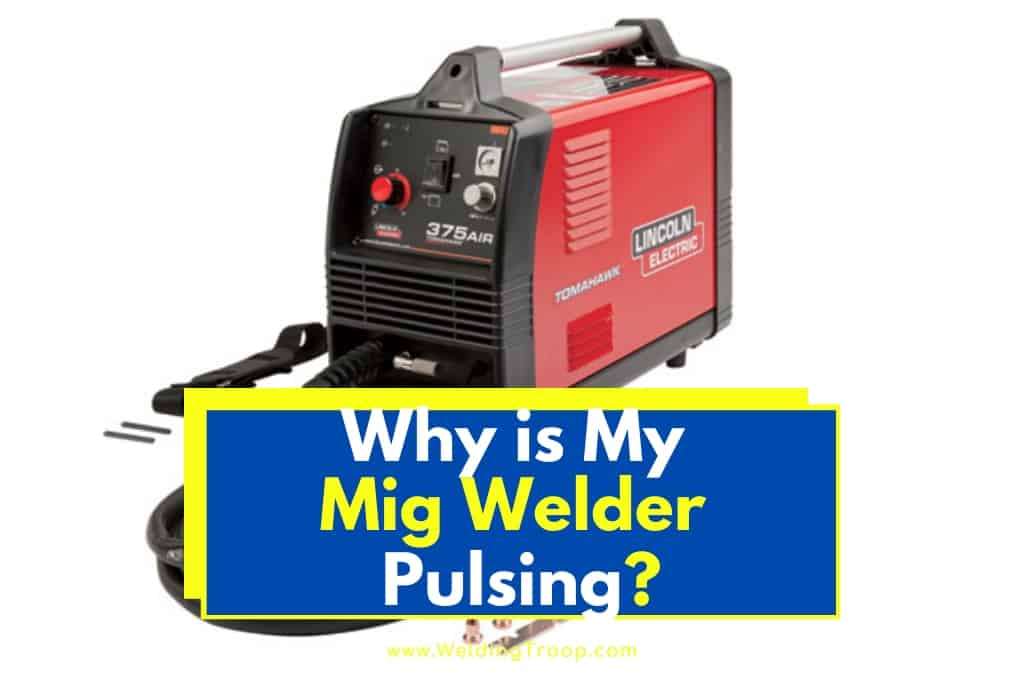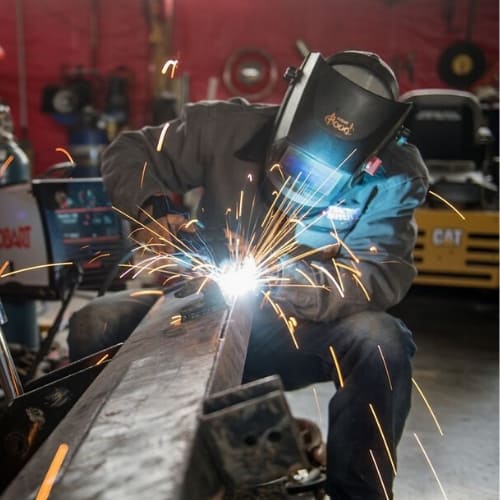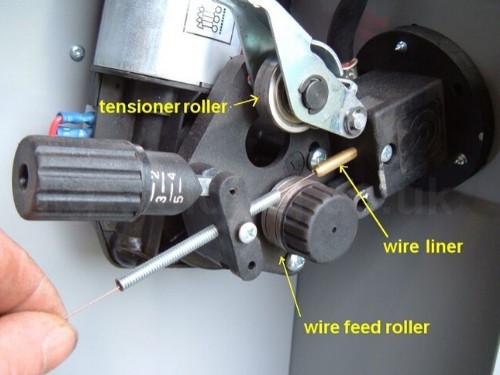My Wire Feed Speed Slow Down When I Start Welding

Pulsing is a very generic term that can describe several problems with a Mig welder. Most are related to setup problems with the welder, such as the settings for temperature, wire feed speed, and mechanical issues such as an obstruction in the feed or the wrong tension obstruction on the welder.
Why is My Mig Welder Pulsing? Pulsing during welding with a Mig Welder can be caused by:
- The wrong tension on the wire feed
- The wire feeing two past or two slow
- Improper power setting on the welder
- A bad ground
- Poor welder maintenance
Diagnosing a problem with your Mig welder can be frustrating. Most people don't realize is that there are variables that work together to produce clean hard welds. Diagnosing problems with your Mig welder, especially those that are of the "pulsea" variety, can get you as hot under the collar as the tip of your welder.
What is "pulsing?"
Before you begin trying to diagnosis a pulsing problem, you need to understand the term when most welders talk about their Mig welder pulsing during welding operations. Most welders refer to pulsing as a condition where the welding machine "pulses" on and off rapidly while welding.
Pulsing is different than using a "Pulsed" welding machine. A "Pulsed" welding machine uses complex electronics to control the temperature, speed, and power going to the welding tip to give a more uniform weld with less spatter, the use of less heat, and savings on wire and gas.

What You Hear When Welding Can be a Clue
Listening as you weld can give you a lot of hints about what is happening at the business end of your torch. When running properly, a MIG weld arc will sound like someone frying bacon . It is a distinctive sound, and almost everyone can identify the distinctive sizzle sound with little pops and spits as the bead moves across the metal.
Any other sounds are an indication that something is amiss and requires immediate investigation. Understanding what can cause a wire feed welder to stutter or pulse is the key to adjusting the machine to eliminate the problems.
Machine Adjustments and Maintenance
Most of the problems with pulsing or stuttering when running a Mig welder trace back to the setting on the machine or the quality of maintenance. A few of the more common problems with maintenance include
- Drive Roll Maintenance – Welding wire is lubricated when it is manufactured and retains some of that lubricant. The drive rollers and the drive roll groove on your machine can become packed with this lubricant. Fouled drive rollers make it harder for the drive rollers to grip the wire. The result is inconsistent feed on the wire, which results in stuttering or pulsing at the torch.
- Drive roller tension to high – To much drive roller tension can add wear and tear on your welding machine. Too much tension can also deform the welding wire. This deformation in the wire can cause feed problems at the tip, causing the wire to jump. This jumping of the wire can cause the stuttering or pulsing at the torch.
- Worn spring liner – The whole cable and hose assembly can be a culprit in pulsing or stuttering in your Mig welder. The spring liner in the assembly will eventually wear at the points that bends occur. The welding wire rubs on these points, wearing groves in the assembly that can become pinch points causing the wire to feed inconsistently. These wear points can become bad enough to cause the wire to stop feeding and created a tangled mess in the wire drive assembly.
- Failure to change tips – The tip of your torch takes a beating. High heat, splatter, and operator abuse (dropping the torch, so the tip bangs on the concrete or work) can take its toll on the tip. A damaged tip can easily become a binding point for the wire and cause stuttering or pulsing at the weld.
- Bad Ground – Maintaining a good circuit is necessary to produce clean even welds. A bad ground caused by a dirty or worn clamp, or a broken or worn ground lead can cause fluctuations in the current from the welder. These fluctuations can produce a stuttering or pulsing effect at the torch as the heat goes up and down at the weld.
How To Find The Correct MIG Welder Settings >> Check out the video below
Get the Setting Right
Using improper setting for the material you are welding or the type of wire you are using to produce your welds can be another cause of pulsing and stuttering with your Mig welder. The most common of these errors in the setup include:
- Too much power – Setting your Mig welder to high or hot can cause several problems at the torch that can resemble pulsing or stuttering. The major problem running too hot is that the welder burns the wire back to the tip of the torch instead of running at the weld. When the arc is broken, there is a split second of dead space, and then the wire advances restarting the arc. The arc effectively burns on and off, creating a pulse.
- Wire-speed settings to low – Often, if the wire feed speed is set to slow, the wire will burn back to the tip, causing a momentary break in the arc. Finding the right wire-speed for your welding technique and the material you are welding can be a bit of a trial and error situation.
- Wire-speed settings to high – Feeding wire to fast can cause the wire to overrun the puddle where the weld is being made. Often the wire will break off, causing a jerking sensation on the torch and leaving small bits of wire fused to the weld. This creates imperfect welds and can be expensive if you are wasting a lot of wire.
- Wrong polarity settings – Make sure that the polarity setting is correct for the type of Mig welding you are doing and the type of wire. Most home and hobby welders use flux-cored wire to eliminate the need for gas shielding. Flux-cored wire requires the polarity on the welder to be DCEN, electrode negative.

The Solutions
If you are experiencing pulsing or stuttering with your Mig Welder, the best method for curing that problem is to make sure that your machine is properly maintained and adjusted. A few simple steps performed on a regular basis can help cure or prevent problems with stuttering or pulsing.
- Inspect the drive rollers, clean, and if worn, replace the rollers
- Clean out the cable/hose assembly when replacing wire by blowing clean air from the torch end of the assembly.
- Inspect the wire coming from the tip of the torch and make sure it is uniformly round and doesn't have spikes or teeth. This can be a symptom of too much tension on the drive rollers
- Periodically look at the spring liner. You can adjust the spring liner by turning it so that the wire is feeding against a different part of the spring liner. This will extend the life of the liner and help prevent chatter or binding of the wire as it runs through the spring liner.
- Replace the tip of your torch regularly. Tips take a lot of abuse and should be routinely replaced.
- Check your ground lead for worn or broken wires, dirty or contaminates clamps, and good tight spring tension.
- Make sure you are feeding the wire through your welder at the proper speed for your welding technique.
- Set the power to match the speed that you weld, the material that you are welding, and the type of wire you are using.
When the Pulse Begins
Mig welders are popular among both professional and amateur hobby welders because they are relatively easy to use, provide great welds, and can be purchased in ranges that fit any budget. Very few welders report chattering or pulsing problems with new welders . Most of the time, these problems start after the welding machine has a few miles on it.
A few easy preventive measures and a little knowledge of materials and settings can usually solve pulsing or stuttering problems with your wire welder. Take your time, pamper your welding machine, and you should be on your way to many hours of pulse-free welding with your Mig welder.
Recommended reading
For more helpful articles about welding please check out our articles below:
What do Welding Shade Numbers Mean? What Shade is Safe?
Six Famous Female Welders
Dangers of Plasma Cutting: Things to Consider and What To Do
Which Metals Can Be MIG Welded?
Here are some of my favorite tools & equipment´s
Thank you for reading this article. I hope it helps you find the most recent and accurate information for your welding project. Here are some tools that I use daily and hope you´ll also find helpful.
There are affiliate links, so if you do decide to use any of them, I´ll earn a small commission. But in all honesty, these are the exact tools that I use and recommend to everyone, even my own family. (NO CRAP)
To see all my of most up-to-date recommendations, check out this resource that I made for you!
Best Overall
Recommendations
+ Great Products & Services
+ Approved
+ Save Thousands of Dollars

Recent Posts
How Much Does Meineke Charge For An Oil Change?
If you're realizing that it's been a while since you last had the oil changed in your car, then you will want to shop around and find the best deal to get the job done. With that in mind, how...
How Much Does Pepboys Charge For An Oil Change?
Changing the oil in your car is a necessity that is all too easy to forget about, and you definitely want to be getting the best deal available when you do get around to doing it. With that in...
Source: https://weldingtroop.com/mig-welder-pulsing/
0 Response to "My Wire Feed Speed Slow Down When I Start Welding"
Postar um comentário